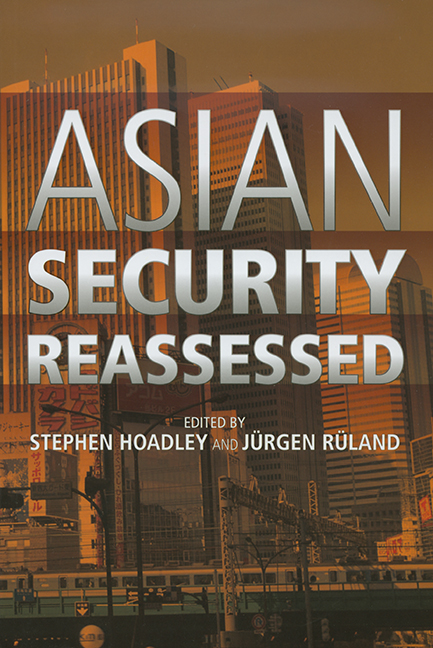Book contents
- Frontmatter
- Contents
- Acknowledgements
- About the Contributors
- List of Abbreviations
- Preface
- Part One Approaches to Asian Security
- Part Two Security Management by Asian States and Regional Institutions
- 2 Asia from Colonialism to Culturalism
- 3 Japan and East Asian Regional Security
- 4 China's Security Strategy and Policies
- 5 United States Security Policies in Asia
- 6 Regional Security Institutions: ASEAN, ARF, SCO and KEDO
- Part Three Non-Traditional Challenges to Asian Security
- Part Four New Concepts of Asian Security
- Index
5 - United States Security Policies in Asia
from Part Two - Security Management by Asian States and Regional Institutions
Published online by Cambridge University Press: 21 October 2015
- Frontmatter
- Contents
- Acknowledgements
- About the Contributors
- List of Abbreviations
- Preface
- Part One Approaches to Asian Security
- Part Two Security Management by Asian States and Regional Institutions
- 2 Asia from Colonialism to Culturalism
- 3 Japan and East Asian Regional Security
- 4 China's Security Strategy and Policies
- 5 United States Security Policies in Asia
- 6 Regional Security Institutions: ASEAN, ARF, SCO and KEDO
- Part Three Non-Traditional Challenges to Asian Security
- Part Four New Concepts of Asian Security
- Index
Summary
INTRODUCTION
The United States was a Pacific power long before it became an Atlantic one. In the early 1840s the United States intensified its commercial engagement in East Asia. Under the terms of the Treaty of Wanghia (1844), America gained the right to trade in Chinese ports. More decisively, in 1853 Commodore Matthew Perry terminated Japan's self-imposed isolation and forced the country to enter into trade with the United States. Both events paved the way for America's later colonial involvement in the region, which took shape with the takeover of the former Spanish colonies in the Philippines and Guam in 1898. In only a dozen decades the United States had experienced a metamorphosis from a colony to a colonial power. Since the late nineteenth century the United States has maintained a preeminent position in the Asia-Pacific, only briefly interrupted by imperial Japan's attempts to establish a “Greater East Asian Co-Prosperity Sphere”, which precipitated the Pacific War.
The defeat of Japan in August 1945 was followed by the emergence of an Asia-Pacific Pax Americana in the post-World War II era. Although the Cold War in the Asia-Pacific was characterized by a tripolar structure with the United States, China and Russia as its poles and shifting power relativities within this triangular order, its dominant element was nevertheless American primacy or, as some argue, hegemony. Unlike Western Europe where the United States’ leading security role was embedded in a multilateral structure centred on the North Atlantic Treaty Organization (NATO), a collection of bilateral alliances with Japan, South Korea, Republic of China on Taiwan and the Philippines served as the ad hoc structure of security relations in the Asia-Pacific. Among those, the U.S.-Japan axis emerged as the most important. In 1951 the United States and Japan signed the San Francisco Peace Treaty and the Mutual Security Treaty. While the first formally ended the American occupation of Japan, the second enshrined Japan's position as Washington's principal Asian ally or, according to some, military satellite. In 1960 a bilateral defence pact between the two nations raised Japan's status because it eliminated earlier provisions allowing the United States to intervene in Japanese politics, provided a nuclear umbrella and obliged the United States to defend Japan if attacked. The pact also required Washington to consult Tokyo regarding use of U.S. military bases in Japan.
- Type
- Chapter
- Information
- Asian Security Reassessed , pp. 106 - 127Publisher: ISEAS–Yusof Ishak InstitutePrint publication year: 2006



